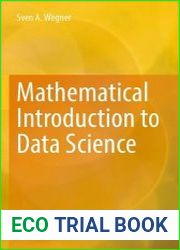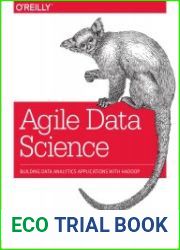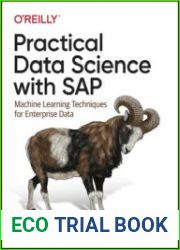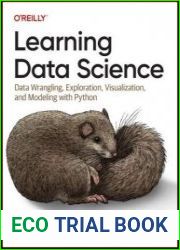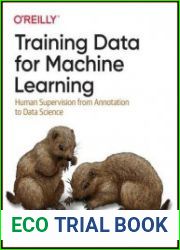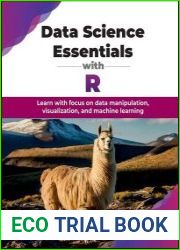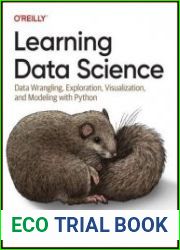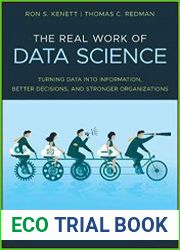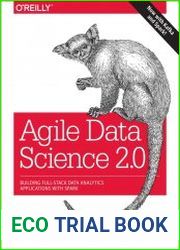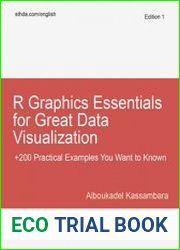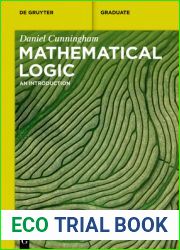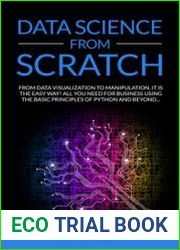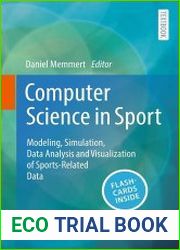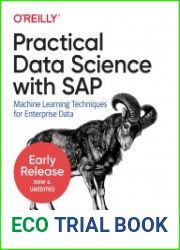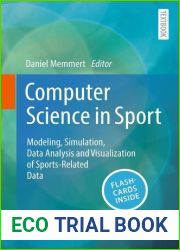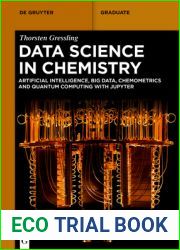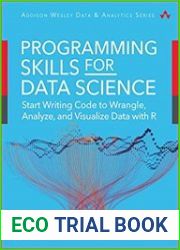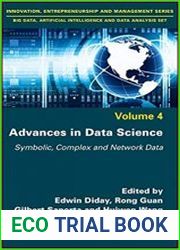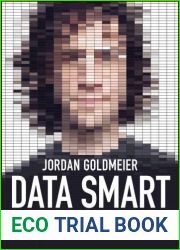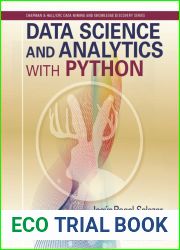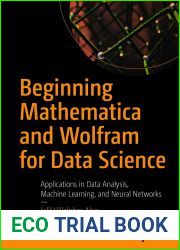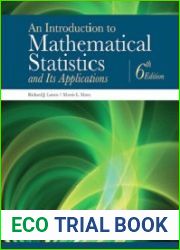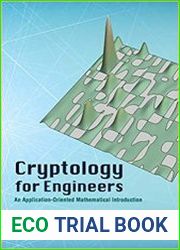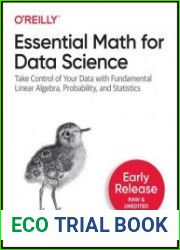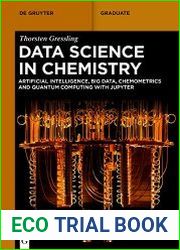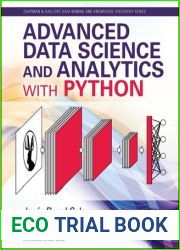
BOOKS - Mathematical Introduction to Data Science

Mathematical Introduction to Data Science
Author: Sven A. Wegner
Year: 2024
Pages: 301
Format: PDF | EPUB
File size: 10.1 MB
Language: ENG

Year: 2024
Pages: 301
Format: PDF | EPUB
File size: 10.1 MB
Language: ENG

Mathematical Introduction to Data Science In today's world, technology is advancing at an unprecedented rate, and it is essential to understand the process of technological evolution to survive and thrive. As a result, the demand for knowledge in data science and machine learning has increased significantly, and students of mathematics are seeking to include these subjects in their standard curricula. The book "Mathematical Introduction to Data Science" addresses this need by providing a rigorous treatment of the subject matter, focusing on profound understanding of the methods discussed, and highlighting their limitations. This textbook is designed for students of mathematics who have completed their foundational courses and wish to specialize in data science and machine learning. The book covers the most critical topics in data science and machine learning, including k-nearest neighbors, linear and logistic regression, clustering, best-fit subspaces, principal component analysis, dimensionality reduction, collaborative filtering, perceptron, support vector machines, the kernel method, gradient descent, and neural networks. With 121 classroom-tested exercises, the book provides a comprehensive introduction to these topics, ensuring that readers gain a deep understanding of the underlying ideas. The need for a personal paradigm for perceiving the technological process of developing modern knowledge is crucial for humanity's survival. The book helps readers develop such a paradigm by presenting canonical data science and machine learning topics in a form tailored to their needs. By doing so, it fosters a profound understanding of the methods discussed, allowing readers to appreciate the significance of each topic and its limitations.
Математическое введение в науку о данных В современном мире технологии развиваются с беспрецедентной скоростью, и важно понимать процесс технологической эволюции, чтобы выжить и процветать. В результате спрос на знания в области науки о данных и машинного обучения значительно возрос, и студенты-математики стремятся включить эти предметы в свои стандартные учебные программы. Книга «Математическое введение в науку о данных» решает эту проблему, предоставляя строгое рассмотрение предмета, фокусируясь на глубоком понимании обсуждаемых методов и подчеркивая их ограничения. Этот учебник предназначен для студентов-математиков, которые закончили свои основополагающие курсы и хотят специализироваться на науке о данных и машинном обучении. Книга охватывает наиболее важные темы в науке о данных и машинном обучении, включая k-ближайших соседей, линейную и логистическую регрессию, кластеризацию, наиболее подходящие подпространства, анализ главных компонентов, уменьшение размерности, совместную фильтрацию, перцептрон, машины опорных векторов, метод ядра, градиентный спуск и нейронные сети. Имея 121 проверенное в классе упражнение, книга содержит исчерпывающее введение в эти темы, гарантирующее читателям глубокое понимание основных идей. Потребность в личной парадигме восприятия технологического процесса развития современных знаний имеет решающее значение для выживания человечества. Книга помогает читателям развивать такую парадигму, представляя канонические темы науки о данных и машинного обучения в форме, адаптированной к их потребностям. Тем самым он способствует глубокому пониманию обсуждаемых методов, позволяя читателям оценить значимость каждой темы и ее ограничения.
Introduction mathématique aux sciences des données Dans le monde d'aujourd'hui, les technologies évoluent à une vitesse sans précédent et il est important de comprendre le processus d'évolution technologique pour survivre et prospérer. En conséquence, la demande de connaissances dans les domaines de la science des données et de l'apprentissage automatique a considérablement augmenté, et les étudiants en mathématiques cherchent à intégrer ces matières dans leurs programmes d'études standard. livre « Introduction mathématique à la science des données » aborde ce problème en fournissant un examen rigoureux du sujet, en se concentrant sur une compréhension approfondie des méthodes discutées et en soulignant leurs limites. Ce manuel est destiné aux étudiants en mathématiques qui ont terminé leurs cours de base et qui veulent se spécialiser dans les sciences des données et l'apprentissage automatique. livre couvre les sujets les plus importants de la science des données et de l'apprentissage automatique, y compris les k-voisins immédiats, la régression linéaire et logistique, le regroupement, les sous-espaces les plus appropriés, l'analyse des composants principaux, la réduction de la dimension, le filtrage collaboratif, le perceptron, les machines de vecteurs de référence, la méthode du noyau, la descente gradiente et les réseaux neuronaux. Avec 121 exercices éprouvés en classe, le livre offre une introduction exhaustive à ces sujets, garantissant aux lecteurs une compréhension approfondie des idées fondamentales. besoin d'un paradigme personnel de perception du processus technologique de développement des connaissances modernes est crucial pour la survie de l'humanité. livre aide les lecteurs à développer un tel paradigme en présentant les thèmes canoniques de la science des données et de l'apprentissage automatique sous une forme adaptée à leurs besoins. Il contribue ainsi à une compréhension approfondie des méthodes discutées, permettant aux lecteurs d'apprécier l'importance de chaque sujet et ses limites.
Introducción matemática a la ciencia de los datos En el mundo actual, la tecnología evoluciona a una velocidad sin precedentes y es importante comprender el proceso de evolución tecnológica para sobrevivir y prosperar. Como resultado, la demanda de conocimientos en ciencia de datos y aprendizaje automático ha aumentado considerablemente, y los estudiantes de matemáticas se esfuerzan por incluir estas materias en sus planes de estudio estándar. libro «Introducción matemática a la ciencia de los datos» resuelve este problema proporcionando una consideración rigurosa del tema, centrándose en una comprensión profunda de los métodos discutidos y enfatizando sus limitaciones. Este libro de texto está dirigido a estudiantes de matemáticas que han terminado sus cursos fundamentales y quieren especializarse en ciencia de datos y aprendizaje automático. libro cubre los temas más importantes en ciencia de datos y aprendizaje automático, incluyendo los vecinos k-cercanos, regresión lineal y logística, clustering, subespacio más adecuado, análisis de componentes principales, reducción de dimensión, filtración colaborativa, perceptron, máquinas de vectores de referencia, método de núcleo, descenso de gradiente y redes neuronales. Con 121 ejercicios probados en clase, el libro contiene una exhaustiva introducción a estos temas, garantizando a los lectores una comprensión profunda de las ideas básicas. La necesidad de un paradigma personal para percibir el proceso tecnológico del desarrollo del conocimiento moderno es crucial para la supervivencia de la humanidad. libro ayuda a los lectores a desarrollar tal paradigma presentando los temas canónicos de la ciencia de los datos y el aprendizaje automático en una forma adaptada a sus necesidades. Al hacerlo, contribuye a una comprensión profunda de los métodos discutidos, permitiendo a los lectores evaluar la importancia de cada tema y sus limitaciones.
Introduzione matematica alla scienza dei dati Nel mondo moderno la tecnologia evolve ad una velocità senza precedenti ed è importante comprendere il processo di evoluzione tecnologica per sopravvivere e prosperare. Di conseguenza, la domanda di conoscenza della scienza dei dati e dell'apprendimento automatico è aumentata notevolmente e gli studenti di matematica cercano di includere queste materie nei loro programmi di studio standard. Il libro «Introduzione matematica alla scienza dei dati» risolve il problema fornendo un'attenta considerazione della materia, focalizzandosi su una profonda comprensione dei metodi discussi e sottolineando le loro limitazioni. Questo manuale è rivolto agli studenti di matematica che hanno completato i loro corsi fondamentali e vogliono specializzarsi in scienze dei dati e apprendimento automatico. Il libro affronta i temi più importanti della scienza dei dati e dell'apprendimento automatico, inclusi i vicini K, la regressione lineare e logistica, il clustering, i sottoprodotti più adatti, l'analisi dei componenti principali, la riduzione della dimensione, il filtraggio congiunto, percrotrone, macchine di supporto vettori, il metodo del nucleo, la discesa gradiente e le reti neurali. Con 121 esercizi collaudati in classe, il libro contiene un'introduzione completa a questi temi che garantisce ai lettori una profonda comprensione delle idee di base. La necessità di un paradigma personale della percezione del processo tecnologico di sviluppo della conoscenza moderna è fondamentale per la sopravvivenza dell'umanità. Il libro aiuta i lettori a sviluppare questo paradigma presentando i temi canonici della scienza dei dati e dell'apprendimento automatico in una forma adattata alle loro esigenze. In questo modo promuove una profonda comprensione dei metodi discussi, permettendo ai lettori di valutare l'importanza di ogni argomento e le sue limitazioni.
Mathematische Einführung in die Datenwissenschaft In der heutigen Welt entwickelt sich die Technologie mit beispielloser Geschwindigkeit, und es ist wichtig, den Prozess der technologischen Evolution zu verstehen, um zu überleben und zu gedeihen. Infolgedessen ist die Nachfrage nach Wissen in den Bereichen Datenwissenschaft und maschinelles rnen erheblich gestiegen, und Mathematikstudenten sind bestrebt, diese Themen in ihre Standardlehrpläne aufzunehmen. Das Buch Mathematical Introduction to Data Science adressiert dieses Problem, indem es eine rigorose Auseinandersetzung mit dem Thema bietet, sich auf ein tiefes Verständnis der diskutierten Methoden konzentriert und ihre Grenzen hervorhebt. Dieses hrbuch richtet sich an Mathematikstudenten, die ihre Gründungskurse abgeschlossen haben und sich auf Datenwissenschaft und maschinelles rnen spezialisieren möchten. Das Buch behandelt die wichtigsten Themen der Datenwissenschaft und des maschinellen rnens, einschließlich k-Nearest Neighbors, lineare und logistische Regression, Clustering, die am besten geeigneten Subräume, Hauptkomponentenanalyse, Dimensionsreduktion, Co-Filterung, Perceptron, Support-Vector-Maschinen, Kernel-Methode, Gradientenabstieg und neuronale Netzwerke. Mit 121 klassenerprobten Übungen bietet das Buch eine umfassende Einführung in diese Themen, die den sern ein tiefes Verständnis der grundlegenden Ideen garantiert. Das Bedürfnis nach einem persönlichen Paradigma der Wahrnehmung des technologischen Prozesses der Entwicklung des modernen Wissens ist entscheidend für das Überleben der Menschheit. Das Buch hilft den sern, ein solches Paradigma zu entwickeln, indem es kanonische Themen der Datenwissenschaft und des maschinellen rnens in einer auf ihre Bedürfnisse zugeschnittenen Form präsentiert. Auf diese Weise fördert es ein tiefes Verständnis der diskutierten Methoden und ermöglicht es den sern, die Bedeutung jedes Themas und seine Grenzen zu beurteilen.
Wprowadzenie matematyczne do Data Science Technology ewoluuje w bezprecedensowym tempie w dzisiejszym świecie i ważne jest, aby zrozumieć proces ewolucji technologicznej, aby przetrwać i prosperować. W rezultacie zapotrzebowanie na wiedzę w zakresie nauki danych i uczenia maszynowego znacznie wzrosło, a studenci matematyki chętnie włączają te tematy do swoich standardowych programów nauczania. Książka „A Mathematical Introduction to Data Science” rozwiązuje ten problem poprzez rygorystyczne rozważenie tematu, skupiając się na głębokim zrozumieniu omawianych metod i podkreślając ich ograniczenia. Podręcznik ten jest dla studentów matematyki, którzy ukończyli swoje kursy podstawowe i chcą specjalizować się w nauce danych i uczeniu maszynowym. Książka obejmuje najważniejsze tematy z zakresu nauki danych i uczenia maszynowego, w tym k-najbliższych sąsiadów, regresji liniowej i logistycznej, klastrowania, najlepiej dopasowanych podprzestrzeni, podstawowej analizy komponentów, redukcji wymiarów, filtrowania współpracy, perceptronu, maszyn wektorowych wsparcia, metody jądra, zejścia gradientów i sieci neuronowych. Dzięki 121 klasowym ćwiczeniom książka zapewnia wszechstronne wprowadzenie do tych tematów, gwarantując czytelnikom głębokie zrozumienie podstawowych pomysłów. Potrzeba osobistego paradygmatu postrzegania technologicznego procesu rozwoju nowoczesnej wiedzy ma kluczowe znaczenie dla przetrwania ludzkości. Książka pomaga czytelnikom rozwijać taki paradygmat, przedstawiając kanoniczne tematy nauki o danych i uczenia maszynowego w formie dostosowanej do ich potrzeb. W ten sposób promuje głębokie zrozumienie omawianych metod, pozwalając czytelnikom docenić znaczenie każdego tematu i jego ograniczeń.
Mathematical Introduction Technology מתפתחת בקצב חסר תקדים בעולם של ימינו, וחשוב להבין את תהליך האבולוציה הטכנולוגית על מנת לשרוד ולשגשג. כתוצאה מכך, הביקוש לידע במדעי המידע ולמידת המכונה גדל באופן משמעותי, ותלמידי מתמטיקה להוטים לשלב את הנושאים הללו בתכנית הלימודים הסטנדרטית שלהם. הספר A Mathematical Introduction to Data Science פותר בעיה זו על ידי מתן עיון קפדני בנושא, תוך התמקדות בהבנה עמוקה של השיטות הנידונות והדגשת מגבלותיהן. ספר הלימוד הזה מיועד לתלמידי מתמטיקה שסיימו את הקורסים היסודיים שלהם ורוצים להתמחות במדעי המידע ולמידת מכונה. הספר סוקר את הנושאים החשובים ביותר במדעי המידע ובלמידת מכונה, כולל שכנים, רגרסיה לינארית ולוגיסטית, קיבוצים, תת-מרחבים מתאימים ביותר, ניתוח רכיבים עיקריים, צמצום ממדי, סינון שיתופי, תפיסה, מכונות וקטוריות תומכות, שיטת גרעין, הורדה מדורגת ורשתות עצביות. עם 121 תרגילים שנבחנו בכיתה, הספר מספק מבוא מקיף לנושאים אלה, המבטיח לקוראים הבנה עמוקה של רעיונות בסיסיים. הצורך בתפיסה אישית של התהליך הטכנולוגי של התפתחות הידע המודרני חיוני להישרדות האנושות. הספר עוזר לקוראים לפתח פרדיגמה כזו על ידי הצגת הנושאים הקאנוניים של מדעי המידע ולימוד מכונה בצורה המותאמת לצורכיהם. בעשותה כן, היא מקדמת הבנה עמוקה של השיטות הנידונות, ומאפשרת לקוראים להבין את משמעות כל נושא ומגבלותיו.''
Veri Bilimine Matematiksel Giriş Teknoloji, günümüz dünyasında benzeri görülmemiş bir hızla gelişmektedir ve hayatta kalmak ve gelişmek için teknolojik evrim sürecini anlamak önemlidir. Sonuç olarak, veri bilimi ve makine öğrenimi alanındaki bilgi talebi önemli ölçüde artmıştır ve matematik öğrencileri bu konuları standart müfredatlarına dahil etmeye isteklidir. "A Mathematical Introduction to Data Science" (Veri Bilimine Matematiksel Bir Giriş) kitabı, bu problemi, konunun titiz bir şekilde incelenmesini sağlayarak, tartışılan yöntemlerin derinlemesine anlaşılmasına odaklanarak ve sınırlamalarını vurgulayarak çözer. Bu ders kitabı, temel derslerini tamamlamış ve veri bilimi ve makine öğrenimi konusunda uzmanlaşmak isteyen matematik öğrencileri içindir. Kitap, k-en yakın komşular, doğrusal ve lojistik regresyon, kümeleme, en uygun alt alanlar, temel bileşen analizi, boyutsallık azaltma, işbirlikçi filtreleme, perceptron, destek vektör makineleri, çekirdek yöntemi, degrade iniş ve sinir ağları dahil olmak üzere veri bilimi ve makine öğrenimi alanındaki en önemli konuları kapsamaktadır. Sınıfta test edilmiş 121 alıştırma ile kitap, bu konulara kapsamlı bir giriş yaparak okuyucuların temel fikirleri derinlemesine anlamalarını garanti eder. Modern bilginin gelişiminin teknolojik sürecinin kişisel bir algı paradigmasına duyulan ihtiyaç, insanlığın hayatta kalması için çok önemlidir. Kitap, okuyucuların veri bilimi ve makine öğreniminin kanonik temalarını ihtiyaçlarına göre uyarlanmış bir biçimde sunarak böyle bir paradigma geliştirmelerine yardımcı olur. Bunu yaparken, tartışılan yöntemlerin derinlemesine anlaşılmasını teşvik eder ve okuyucuların her konunun önemini ve sınırlamalarını takdir etmelerini sağlar.
تتطور المقدمة الرياضية لتكنولوجيا علوم البيانات بمعدل غير مسبوق في عالم اليوم، ومن المهم فهم عملية التطور التكنولوجي من أجل البقاء والازدهار. نتيجة لذلك، زاد الطلب على المعرفة في علوم البيانات والتعلم الآلي بشكل كبير، ويتوق طلاب الرياضيات إلى دمج هذه المواد في مناهجهم القياسية. يحل كتاب «مقدمة رياضية لعلوم البيانات» هذه المشكلة من خلال تقديم دراسة صارمة للموضوع، مع التركيز على فهم عميق للطرق التي تمت مناقشتها والتأكيد على حدودها. هذا الكتاب المدرسي مخصص لطلاب الرياضيات الذين أكملوا دوراتهم التأسيسية ويريدون التخصص في علوم البيانات والتعلم الآلي. يغطي الكتاب أهم الموضوعات في علوم البيانات والتعلم الآلي، بما في ذلك أقرب الجيران، والانحدار الخطي واللوجستي، والتجميع، والفضاءات الفرعية الأكثر ملاءمة، وتحليل المكونات الرئيسية، وتقليل الأبعاد، والتصفية التعاونية، والإدراك، وآلات متجهات الدعم، طريقة النواة، هبوط التدرج، والشبكات العصبية. مع 121 تمرينًا تم اختباره في الفصل الدراسي، يقدم الكتاب مقدمة شاملة لهذه الموضوعات، مما يضمن للقراء فهمًا عميقًا للأفكار الأساسية. والحاجة إلى نموذج شخصي لتصور العملية التكنولوجية لتطوير المعرفة الحديثة أمر بالغ الأهمية لبقاء البشرية. يساعد الكتاب القراء على تطوير مثل هذا النموذج من خلال تقديم الموضوعات القانونية لعلوم البيانات والتعلم الآلي في شكل مصمم خصيصًا لاحتياجاتهم. من خلال القيام بذلك، فإنه يعزز فهمًا عميقًا للأساليب التي تمت مناقشتها، مما يسمح للقراء بتقدير أهمية كل موضوع وقيوده.
數據科學的數學介紹在當今世界,技術以前所未有的速度發展,了解技術進化的過程對於生存和繁榮至關重要。結果,對數據科學和機器學習知識的需求大大增加,數學專業的學生渴望將這些科目納入其標準課程。「數據科學的數學介紹」一書通過對主題進行嚴格的考慮,著重於對所討論方法的深入理解並強調其局限性來解決這一問題。本教科書面向那些已經完成基礎課程並希望專門研究數據科學和機器學習的數學學生。該書涵蓋了數據科學和機器學習領域最重要的主題,包括k近鄰,線性和邏輯回歸,聚類,最合適的子空間,主成分分析,維數降低,聯合過濾,知覺器,參考向量機,核心方法,梯度下降和神經網絡。該書有121個經過課堂驗證的練習,對這些主題進行了詳盡的介紹,以確保讀者對基本思想有深刻的了解。需要個人範式來理解現代知識發展的過程過程對人類的生存至關重要。該書通過以適合其需求的形式介紹數據科學和機器學習的規範主題,幫助讀者發展這種範式。通過這樣做,它有助於深入了解所討論的方法,使讀者能夠評估每個主題的重要性及其局限性。







